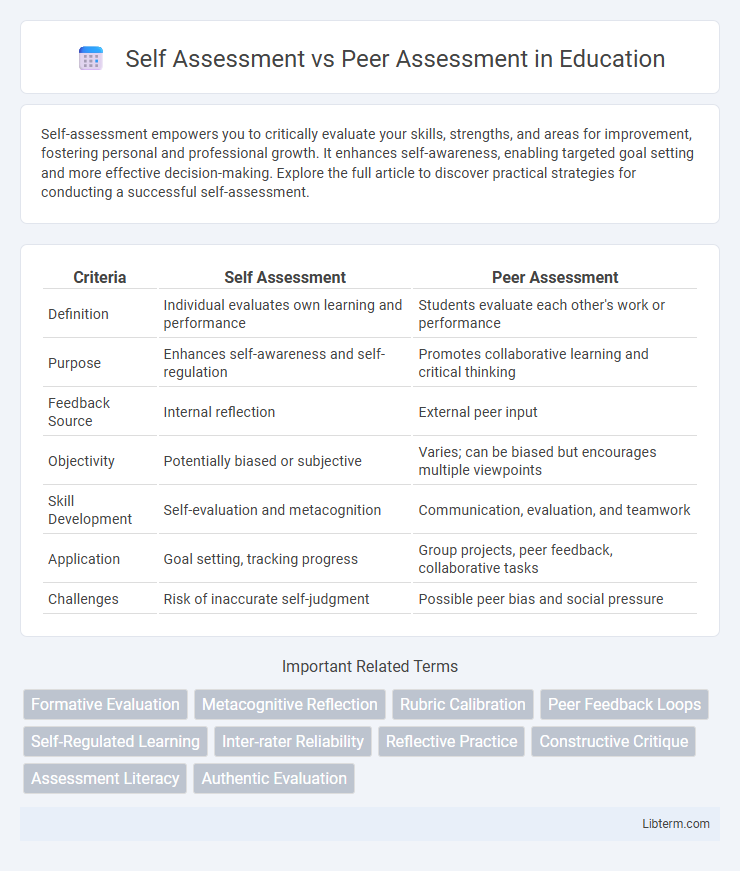Self-assessment empowers you to critically evaluate your skills, strengths, and areas for improvement, fostering personal and professional growth. It enhances self-awareness, enabling targeted goal setting and more effective decision-making. Explore the full article to discover practical strategies for conducting a successful self-assessment.
Table of Comparison
| Criteria | Self Assessment | Peer Assessment |
|---|---|---|
| Definition | Individual evaluates own learning and performance | Students evaluate each other's work or performance |
| Purpose | Enhances self-awareness and self-regulation | Promotes collaborative learning and critical thinking |
| Feedback Source | Internal reflection | External peer input |
| Objectivity | Potentially biased or subjective | Varies; can be biased but encourages multiple viewpoints |
| Skill Development | Self-evaluation and metacognition | Communication, evaluation, and teamwork |
| Application | Goal setting, tracking progress | Group projects, peer feedback, collaborative tasks |
| Challenges | Risk of inaccurate self-judgment | Possible peer bias and social pressure |
Introduction to Assessment Methods
Self-assessment encourages learners to evaluate their own work, fostering self-reflection and critical thinking, whereas peer assessment involves students reviewing each other's contributions, promoting collaborative learning and diverse feedback. Both methods enhance formative assessment by providing insights beyond instructor evaluation, improving student engagement and understanding. Effective implementation requires clear criteria and training to ensure reliable and constructive feedback.
Defining Self Assessment
Self assessment is a reflective process where individuals evaluate their own performance, skills, and understanding against set criteria or objectives. It fosters personal accountability by encouraging learners to identify strengths and areas for improvement through honest self-evaluation. This method enhances metacognitive skills by promoting self-awareness and critical thinking in educational and professional settings.
Understanding Peer Assessment
Peer assessment enhances critical thinking by encouraging students to evaluate their classmates' work, providing diverse perspectives that deepen understanding. It fosters collaborative learning and accountability, as students actively engage in the assessment process rather than passively receiving feedback. This method complements self-assessment by introducing external viewpoints, promoting a more comprehensive evaluation of skills and knowledge.
Key Differences Between Self and Peer Assessment
Self assessment involves individuals evaluating their own performance or work, fostering personal reflection and self-awareness. Peer assessment requires individuals to evaluate the work or performance of others, providing diverse feedback and promoting critical analysis from multiple perspectives. Key differences include the source of feedback--internal versus external--and the potential for bias, where self assessment may lead to over- or underestimation, while peer assessment introduces variability based on peers' knowledge and objectivity.
Benefits of Self Assessment
Self-assessment enhances learner autonomy by encouraging individuals to critically evaluate their own work, leading to deeper reflection and improved metacognitive skills. It promotes personalized goal-setting and fosters a sense of responsibility for one's own learning progress, which can increase motivation and engagement. Furthermore, self-assessment provides immediate feedback that helps learners identify strengths and areas for improvement without dependence on external evaluators.
Advantages of Peer Assessment
Peer assessment enhances critical thinking by allowing students to evaluate diverse perspectives, fostering deeper understanding and engagement with the material. It promotes collaborative learning and communication skills, as peers provide constructive feedback that encourages reflection and improvement. This method also increases accountability and motivation, since students recognize the value of contributing to their peers' development.
Challenges in Self and Peer Assessment
Self-assessment challenges include bias, lack of objectivity, and limited self-awareness, which can lead to inaccurate evaluations and inflated or deflated performance ratings. Peer assessment difficulties involve potential social pressure, interpersonal conflicts, and inconsistent criteria application, resulting in unfair or subjective feedback. Both methods require clear guidelines and training to enhance reliability and reduce evaluation errors.
Impact on Learning Outcomes
Self assessment encourages learners to develop critical thinking and self-regulation skills by reflecting on their own performance, which enhances metacognitive awareness and promotes deeper understanding. Peer assessment provides diverse feedback, increases engagement, and facilitates collaborative learning, leading to improved communication skills and knowledge retention. Combining both methods maximizes learning outcomes by fostering autonomy and social interaction, essential for comprehensive educational development.
Best Practices for Effective Assessment
Effective assessment balances self-assessment and peer assessment by fostering reflective practice and constructive feedback. Employ clear rubrics and criteria to standardize evaluations, ensuring consistency and transparency during both self and peer reviews. Encourage anonymity in peer assessments to reduce bias and train students in giving specific, actionable feedback to enhance learning outcomes.
Choosing the Right Assessment Method
Selecting the appropriate assessment method depends on the learning objectives and desired outcomes; self-assessment promotes metacognition and personal responsibility by encouraging learners to reflect on their own performance, while peer assessment fosters critical thinking and collaborative skills through evaluation by classmates. Self-assessment is most effective when learners have a clear understanding of criteria and seek to develop self-regulation, whereas peer assessment excels in contexts that value diverse perspectives and constructive feedback. Balancing these methods can optimize skill development, enhance engagement, and provide comprehensive insights into learner progress.
Self Assessment Infographic

 libterm.com
libterm.com